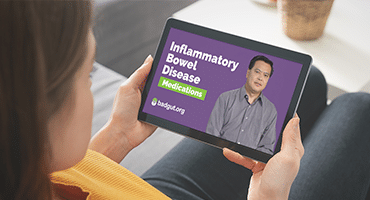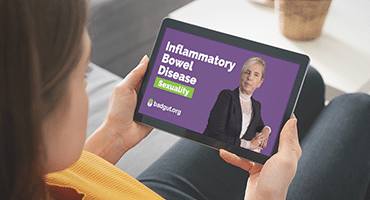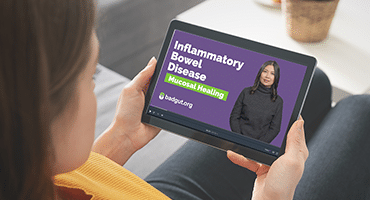
IBD (Crohn’s & Colitis) Overview Video
Featuring
James R. Gray, MD, CCFP, ABIM, FRCPC
Gastroenterologist
Clinical Professor, University of British Columbia
Chair, Medical Advisory Council,
Gastrointestinal Society and Canadian Society of Intestinal Research
Video Transcript
Getting a diagnosis of inflammatory bowel disease, or IBD, can be life-altering. If you or a close friend or family member have this disease, you’ve probably got a lot of questions. In this video, I am going to go over the basics and address some of those concerns.
First of all, what exactly is IBD? The basic underlying feature of IBD is chronic inflammation of a part of the digestive tract. This inflammation can cause many painful and often debilitating symptoms. Because of this, individuals with IBD often have a lower quality of life. However, with proper treatment, IBD will not affect the length of your life and it can usually be successfully managed, although not cured.
There are multiple diseases that fall within the IBD umbrella. Most people with IBD have either Crohn’s disease or ulcerative colitis, but there are many other types of IBD. This video primarily focuses on Crohn’s disease and ulcerative colitis.
It is important to note that IBD is not the same thing as IBS. While they have similar acronyms and both affect the digestive system, they have different underlying causes, symptoms, experiences, and treatment methods. IBS stands for irritable bowel syndrome, which is a functional gastrointestinal condition. This means that its symptoms are a result of poor gut function and motility rather than damage or inflammation to the gut.
IBD, on the other hand, involves visible damage to the gastrointestinal tract.
Remember that every person is unique, so while there are many symptoms and experiences that are common in IBD, they might not apply to you. If you ever have any questions or concerns about your digestive health, make sure you speak about them with your healthcare provider.
If you’ve received a diagnosis of IBD, you might wonder why. While we don’t know for sure what causes IBD, research suggests that interactions between environmental factors, intestinal bacteria, immune dysregulation, and genetic predisposition are responsible.
For example, if you have a close family member with IBD, you have a higher chance of developing it yourself than someone who doesn’t.
IBD can affect anyone of any race, sex, and age. Most people first experience symptoms in childhood or early adulthood, but some might not develop the disease until they are much older. Approximately 0.7% of Canadians, or about 270,000 individuals in this country, have IBD, with slightly more having Crohn’s disease than ulcerative colitis.
While Crohn’s disease and ulcerative colitis are both types of IBD, there are quite a few differences between them. To understand how they can have different symptoms and treatments, we need to look at how they affect the gut.
In ulcerative colitis, inflammation only affects the colon, also called the large intestine. It always begins at the anus and then progresses upward, affecting just the inner lining of the colon. At its largest extent, the inflammation can affect the entire large intestine.
In Crohn’s disease, inflammation can affect any part of the digestive system, in multiple patches or one large section, and can penetrate the entire thickness of the bowel wall. It often affects the small intestine, especially the lowest portion or terminal ileum which is the part of the gut that absorbs most of the nutrients from the food we eat.
The digestive tract is where we digest, process, and absorb food and how we get all the energy and nutrients that keep our bodies running. Because of this, disease in the gut can cause many symptoms. The most common symptom of IBD is diarrhea, which is often very watery. This occurs because inflammation causes food to pass through the digestive system too quickly, so the colon doesn’t have enough time to absorb water from waste.
Diarrhea can also be covered in mucus or be bloody, especially in those with ulcerative colitis, which can cause bleeding ulcerations in the lower part of the colon.
Crohn’s disease can affect the small intestine and, in doing so, it may prevent the proper absorption of food, resulting in diarrhea that is fatty, along with nutritional deficiencies and weight loss. These symptoms can be especially devastating in young children, who might not get enough nutrients to grow properly.
If you have IBD, you are likely familiar with the intense abdominal pain that it can cause. This is often due to spasms from the inflamed intestine putting pressure on the nerve endings in the bowel wall. Pain can vary in severity and tends to be cramping.
Sometimes pain can result from pressure building up behind a narrowed portion of the intestine, known as a stricture, which forms as a result of inflammation. This typically requires immediate treatment, and sometimes surgical intervention.
Fever is quite common, as is the feeling of incomplete defecation. You might also experience a sudden, strong urge to pass stool. Sometimes even false alarms.
There is also a chance that you could develop iron deficiency anemia, either from poor absorption of iron or from excessive iron loss through rectal bleeding.
Some less common symptoms of IBD include nausea, vomiting, loss of appetite, and constipation. Manifestations of inflammation outside of the gut are also possible, and include arthritis, skin problems, liver disease, kidney stones, and eye inflammation.
In Crohn’s disease, the formation of painful inflamed slits in the skin and superficial tissues, called anal fissures, can occur. You can also develop abscesses, which are very painful and can cause fever, or an abnormal, tunnel-like connection between the intestine and the skin, called a fistula. Fistulae can also occur near the opening of the anus, between loops of intestine within the abdomen, or between the intestine and the abdominal wall.
When you receive treatment for IBD, the goal is to reduce inflammation and improve symptoms as much as possible, also known as remission. If your symptoms return, especially if they are worse than before, we call that a flare. It is important to continue taking any medications your doctor prescribes, even if you feel better, to give yourself the best chance at avoiding a flare. Remember that medications are designed to control and reduce inflammation but also to maintain that control once obtained.
When you go to your doctor with digestive symptoms, there are many possible causes that he or she will need to investigate. If you haven’t been diagnosed with IBD, but are wondering if you might have it, here are some of the steps your doctor will take to find out.
First, he or she will carefully evaluate your symptom history and review factors such as when and how your symptoms began, what subsequent problems you experienced, the nature of your diarrhea, the type of abdominal pain, as well as the characteristics and quantity of rectal bleeding.
If your symptoms point to IBD, your physician will use diagnostic tools to look for signs of disease in the digestive tract.
Stool studies are helpful at the outset to rule out infections and to even measure inflammatory products within the stool through a relatively new test called fecal calprotectin. Similarly, blood tests are used to indicate the degree of inflammation and its effect on the body.
For ulcerative colitis, the most useful diagnostic tool is the sigmoidoscope, a short instrument that allows visualization of the inside of the lower bowel and demonstration of inflammation.
If necessary, during this procedure your physician can biopsy any suspected areas for further investigation.
If needed, a longer, flexible instrument called a colonoscope can help your physician see farther up into the colon, sometimes as far as the terminal ileum, where the small and large intestine meet, which is a likely location for the formation of Crohn’s disease.
In some cases, a gastroscope, entering the body via the mouth, is useful to confirm Crohn’s disease in the upper part of the GI tract.
Other diagnostic tools include imaging by ultrasound, CT or MRI, blood tests, and examination of a stool sample for infectious agents.
Treatment for IBD typically involves lifelong management with different types and doses of medications. However, diet and lifestyle factors can also play an important role. Some individuals might also require surgery. Watch our other videos to learn more about the treatment options for individuals with IBD.
The future of IBD lies in education and research. Education of both the public and the medical profession to emphasize the importance of inflammatory bowel disease research is vital.
A partnership between physicians and researchers interested in the study of these diseases, along with those who have IBD, their families, and their friends, is the best hope toward finding the cause or causes, and the cure, of inflammatory bowel disease.




